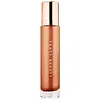What's inside
What's inside
 Key Ingredients
Key Ingredients

 Benefits
Benefits

No benefits
 Concerns
Concerns

 Ingredients Side-by-side
Ingredients Side-by-side

Caprylic/Capric Triglyceride
MaskingRicinus Communis Seed Oil
MaskingHydrogenated Castor Oil
EmollientJojoba Esters
EmollientDiisostearyl Malate
EmollientSimmondsia Chinensis Seed Oil
EmollientOryza Sativa Bran Wax
Skin ConditioningShea Butter Ethyl Esters
EmollientHydrogenated Polybutene
Microcrystalline Wax
Emulsion StabilisingParfum
MaskingCI 77491
Cosmetic ColorantTitanium Dioxide
Cosmetic ColorantMica
Cosmetic ColorantTin Oxide
AbrasiveSynthetic Fluorphlogopite
Calcium Sodium Borosilicate
Caprylic/Capric Triglyceride, Ricinus Communis Seed Oil, Hydrogenated Castor Oil, Jojoba Esters, Diisostearyl Malate, Simmondsia Chinensis Seed Oil, Oryza Sativa Bran Wax, Shea Butter Ethyl Esters, Hydrogenated Polybutene, Microcrystalline Wax, Parfum, CI 77491, Titanium Dioxide, Mica, Tin Oxide, Synthetic Fluorphlogopite, Calcium Sodium Borosilicate
Ingredients Explained
These ingredients are found in both products.
Ingredients higher up in an ingredient list are typically present in a larger amount.
Calcium Sodium Borosilicate is a bulking agent. It is considered a borosilicate glass; it is composed of powder or flakes of calcium and sodium borosilicates.
This ingredient is used to add volume, shine, and color to products. You'll most likely find this ingredient in makeup products.
According to in-vivo and ex-vivo studies done by a manufacturer, this ingredient works well with UV filters:
Learn more about Calcium Sodium BorosilicateParfum is a catch-all term for an ingredient or more that is used to give a scent to products.
Also called "fragrance", this ingredient can be a blend of hundreds of chemicals or plant oils. This means every product with "fragrance" or "parfum" in the ingredients list is a different mixture.
For instance, Habanolide is a proprietary trade name for a specific aroma chemical. When used as a fragrance ingredient in cosmetics, most aroma chemicals fall under the broad labeling category of “FRAGRANCE” or “PARFUM” according to EU and US regulations.
The term 'parfum' or 'fragrance' is not regulated in many countries. In many cases, it is up to the brand to define this term.
For instance, many brands choose to label themselves as "fragrance-free" because they are not using synthetic fragrances. However, their products may still contain ingredients such as essential oils that are considered a fragrance by INCI standards.
One example is Calendula flower extract. Calendula is an essential oil that still imparts a scent or 'fragrance'.
Depending on the blend, the ingredients in the mixture can cause allergies and sensitivities on the skin. Some ingredients that are known EU allergens include linalool and citronellol.
Parfum can also be used to mask or cover an unpleasant scent.
The bottom line is: not all fragrances/parfum/ingredients are created equally. If you are worried about fragrances, we recommend taking a closer look at an ingredient. And of course, we always recommend speaking with a professional.
Learn more about ParfumSynthetic Fluorphlogopite is the synthethic version of mica. It consists of fluorine, aluminum and silicate.
Synthetic Fluorphlogopite is used to add volume to products.
It is considered non-irritating on the skin.
Learn more about Synthetic FluorphlogopiteTin Oxide is an inorganic oxide used to add opacity and volume to a product. In nature, it is already found in mineral form. The main ore of tin is an opaque and shiny mineral called casseterite.
Tin Oxide helps remove translucency in a product, or make it more opaque. Besides adding opacity, tin oxide is used for bulking to add volume.